Venice Travel Guide
Venice (Italian Venezia) is a city steeped in history, with its origins dating back to the 5th century AD. It was founded by refugees fleeing barbarian invasions in northern Italy, who sought refuge on the marshy islands of the Venetian Lagoon. Over the centuries, the city grew and prospered, becoming a major maritime power and a vital center of trade between Europe and the East. Its wealth and influence culminated in the Renaissance era, when Venice was a cultural and artistic hub, attracting renowned artists and thinkers. Today, Venice’s rich history is reflected in its stunning architecture, art, and traditions, making it a must-visit destination for travelers from around the world.
Venice is a one-of-a-kind city, famous for its unique geography and remarkable architecture. The city is situated on 118 small islands in the Venetian Lagoon, separated by a network of canals and connected by over 400 bridges. This distinctive layout gives Venice its unmistakable charm, as streets give way to waterways and boats become the primary mode of transportation.
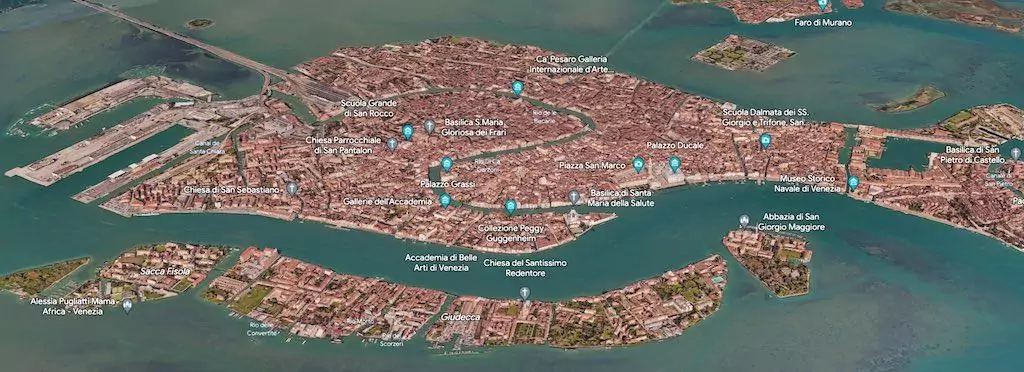
The architecture of Venice is an eclectic mix of styles, reflecting the city’s storied past and its position as a crossroads of East and West. Venetian buildings showcase Byzantine, Gothic, Renaissance, and Baroque influences, with ornate facades, intricate mosaics, and graceful arches. Iconic structures such as St. Mark’s Basilica, the Doge’s Palace, and the Rialto Bridge stand as testaments to Venice’s architectural prowess and rich history. This extraordinary blend of geography and architecture has made Venice a UNESCO World Heritage Site and an enduringly popular destination for travelers from around the world.
Table of Contents
Best Time to Visit
Weather considerations
Venice’s weather can vary significantly throughout the year, making it essential to consider the climate when planning your trip. The city experiences a humid subtropical climate, with cool winters and warm, humid summers. During the winter months (December to February), temperatures can drop as low as 32°F (0°C), and Venice is prone to the acqua alta phenomenon, causing temporary flooding in some areas. Winter also brings damp conditions and the possibility of rain or even snow.
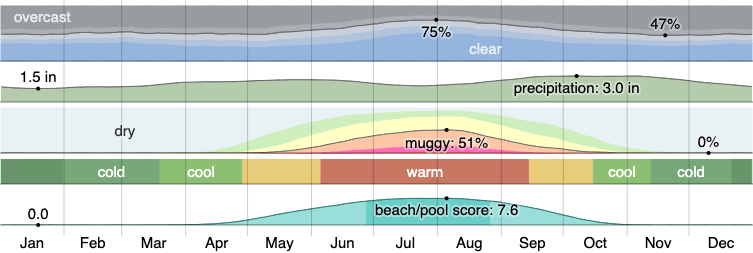
Summers in Venice (June to August) can be hot and humid, with temperatures reaching up to 86°F (30°C). This season also sees increased tourist activity, which can lead to crowded streets and attractions. However, the shoulder seasons of spring (April to June) and fall (September to November) offer milder temperatures and fewer crowds, making these periods ideal for visiting the city. Spring and fall weather is generally pleasant, with comfortable temperatures and lower humidity levels. Keep in mind that Venice can experience sudden rain showers, so it’s wise to pack a lightweight, waterproof jacket regardless of the season.
Festivals and events
Venice is known for its vibrant festivals and events that showcase the city’s rich history, culture, and artistry. The most famous of these is the annual Carnevale di Venezia (Venice Carnival), which takes place in February or early March. The Carnival is a two-week celebration filled with masquerade balls, street performances, and elaborate costumes, harking back to the city’s opulent past.
Another notable event is the Venice International Film Festival, held in late August or early September on the Lido island. As the world’s oldest film festival, it attracts A-list celebrities, filmmakers, and cinephiles from around the globe.
Other prominent events include the Festa del Redentore in July, a religious festival commemorating the end of a devastating plague in the 16th century. The celebrations involve a spectacular fireworks display, gondola regattas, and a temporary floating bridge connecting the Zattere to the Redentore Church on Giudecca Island.
The Regata Storica, held on the first Sunday of September, is another colorful event featuring a historical parade of traditional boats and a thrilling gondola race along the Grand Canal.
No matter when you visit, Venice’s diverse array of festivals and events offer unique experiences that showcase the city’s fascinating blend of history and contemporary culture.
Avoid Peak Tourist Season
Avoiding the peak tourist season in Venice can greatly enhance your experience of this enchanting city. The busiest months are typically June, July, and August, when the city is crowded with tourists and the weather can be hot and humid. During these months, popular attractions such as St. Mark’s Square, the Doge’s Palace, and the Rialto Bridge are often swarmed with visitors, leading to long queues and congested walkways.
By choosing to visit during the shoulder seasons of April-May or September-October, you can enjoy milder weather, fewer crowds, and generally more pleasant conditions. Winter months (excluding Carnival time) can also offer a unique perspective of Venice, with the city shrouded in mist and a more tranquil atmosphere. By planning your trip outside of peak tourist season, you’ll have a better opportunity to explore Venice’s enchanting canals, narrow streets, and historic sites at a more leisurely pace, allowing you to truly appreciate the city’s captivating charm.
Top Attractions in Venice
Tips: We recommend to purchase Venezia Unica’s City Pass 30 days ahead of your trip.
- St. Mark’s Square (Piazza San Marco)
- Ticket price: Free entry
- Tip: Arrive early to avoid long queues, and remember to dress modestly as it is a religious site.
- Doge’s Palace (Palazzo Ducale)
- Official ticket URL: https://www.visitmuve.it/en/tickets/
- Ticket price: €25 full ticket, €13 reduced ticket if book 30 days ahead. Otherwise €30 full ticket, €15 reduced
- Included in the Venice Museum Pass for a better price.
- Opening hours: Daily 8:30 am – 7:00 pm
- Address: Piazza San Marco, 1, 30124 Venezia VE, Italy
- Tip: Consider purchasing a combined ticket for multiple attractions to save money.
- St. Mark’s Basilica (Basilica di San Marco)
- Official ticket URL: http://www.basilicasanmarco.it
- Ticket price: the entrance is free but there are three internal areas that requires extra tickets and those tickets are not included in the Venezia Unica’s City Pass.
- Entrance: €3 (used to be free, started to charging after COVID)
- St Mark’s Museum: €7 Check the information below
- Golden Altarpiece (Pala d’oro) €5 Check the information below
- Opening hours: Mon-Sat 9:30 am – 5:15 pm, Sun 2:00 pm – 5:00 pm (summer), 2:00 pm – 4:30 pm (winter)
- Address: Piazza San Marco, 328, 30100 Venezia VE, Italy
- Tip: Book a guided tour to learn more about the Basilica’s history and art.
- Peggy Guggenheim Collection
- Official ticket URL: https://www.guggenheim-venice.it/en/visit/tickets/ or Venezia Unica
- Ticket price: €16 full ticket, €9 reduced ticket
- Opening hours: Wed-Mon 10:00 am – 6:00 pm, closed on Tuesdays
- Address: Dorsoduro, 701-704, 30123 Venezia VE, Italy
- Tip: Purchase tickets online in advance to avoid queues.
- Rialto Bridge (Ponte di Rialto)
- Official ticket URL: N/A (Free attraction)
- Ticket price: Free
- Opening hours: 24 hours
- Tip: Visit early morning or late evening to avoid the crowds and capture stunning photos.
- Bridge of Sighs (Ponte dei Sospiri)
- Ticket price: Free
- Opening hours: 24 hours
- Tip: For the best view, head to the nearby Ponte della Paglia.
- Bridge of Academia (Ponte dell’Accademia)
- Ticket price: Free
- Opening hours: 24 hours
- Santa Maria della Salute
- Ticket price: Free
- Opening hours: Mon-Sat 9:00 am – 12:00 pm, 3:00 pm – 5:30 pm; Sun 3:00 pm – 5:30 pm Address: Dorsoduro, 1, 30123 Venezia VE, Italy
- Tip: Attend a classical music concert held inside the basilica for a unique experience.
- Murano Island
- Official ticket URL: N/A (Free attraction)
- Ticket price: Free, but vaporetto ticket required (€7.50 one way), check the Venice water-bus pass
- Opening hours: 24 hours
- Tip: Take a guided tour to learn about Murano’s glass-making history and visit a glass factory.
- Burano Island
- Official ticket URL: N/A (Free attraction)
- Ticket price: Free, but vaporetto ticket required (€7.50 one way), check the Venice water-bus pass
- Opening hours: 24 hours
- Tip: Spend a leisurely afternoon exploring the island’s colorful streets and local lace shops.
St. Mark’s Square (Piazza San Marco)
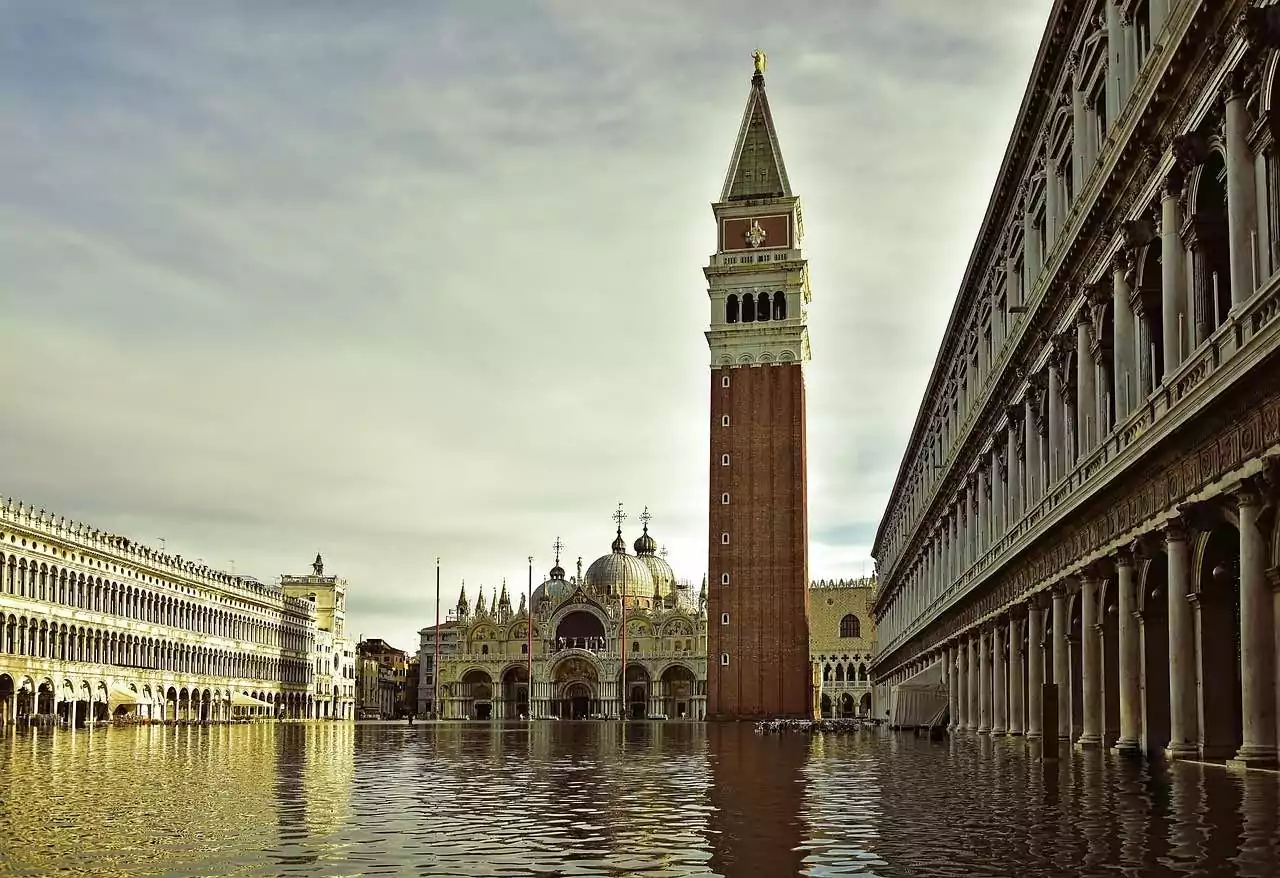
St. Mark’s Square, also known as Piazza San Marco, is the heart of Venice and an iconic destination for visitors. This expansive square is surrounded by stunning architecture, including St. Mark’s Basilica, Doge’s Palace, and the Campanile bell tower. The square has been a central gathering place for centuries, where locals and tourists alike come to soak in the history and atmosphere. As you stroll through the square, you’ll be mesmerized by the harmonious blend of Venetian, Byzantine, and Gothic architectural styles. Enjoy a coffee at one of the historic cafes, like the famous Caffè Florian, as you listen to live orchestras playing in the background. While St. Mark’s Square can be crowded during peak times, its beauty and charm make it a must-visit destination when exploring Venice.
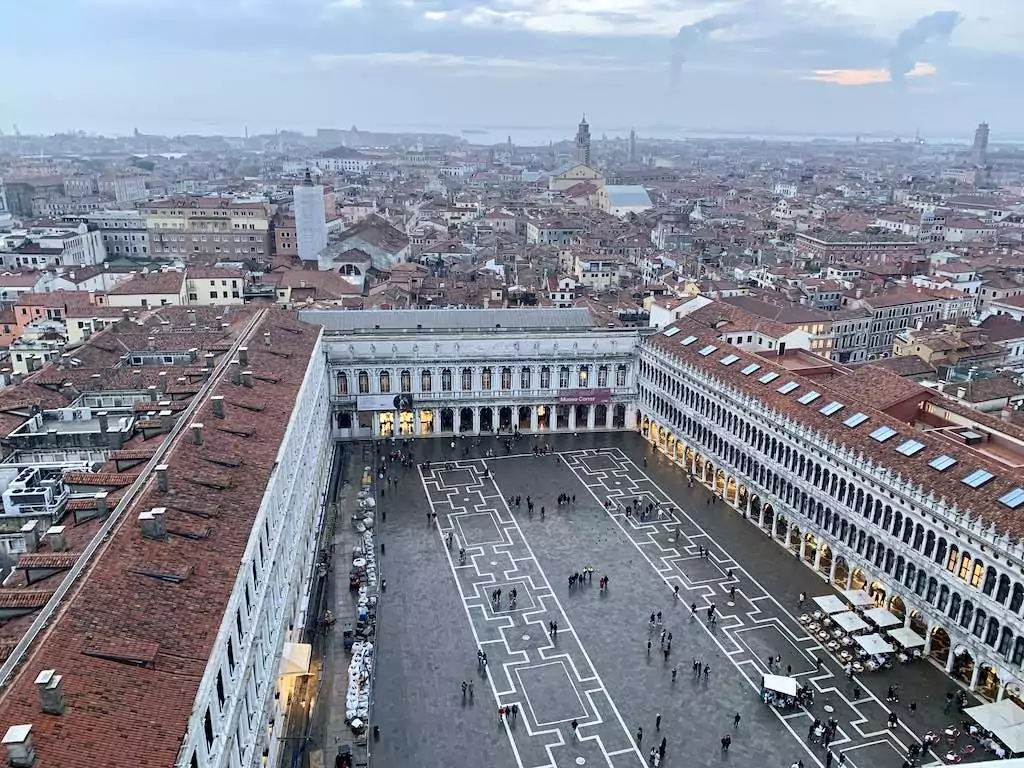
Doge’s Palace (Palazzo Ducale)
Doge’s Palace, or Palazzo Ducale, is a masterpiece of Venetian Gothic architecture and a symbol of Venice’s wealth and power throughout history. Located on the edge of St. Mark’s Square, the palace was once the residence of the Doge, the supreme ruler of the Venetian Republic, and the seat of the city’s government. As you explore the opulent rooms and grand halls adorned with frescoes, sculptures, and ornate decorations, you’ll gain insight into the splendor of Venice’s past. The palace also houses an impressive collection of art by renowned artists such as Titian, Tintoretto, and Veronese.
Be sure to take photo of the famous Bridge of Sighs from the Doge’s Palace, which connects the palace to the old prison, offering a unique perspective on the city’s history.
Don’t Miss:
- Sala del Maggior Consiglio (Grand Council Chamber)
- Sala dello Scudo (Shield Room)
- Scala d’Oro (Golden Staircase)
- Anticollegio (Council Antechamber)
- Scala dei Giganti (Giants’ Staircase)
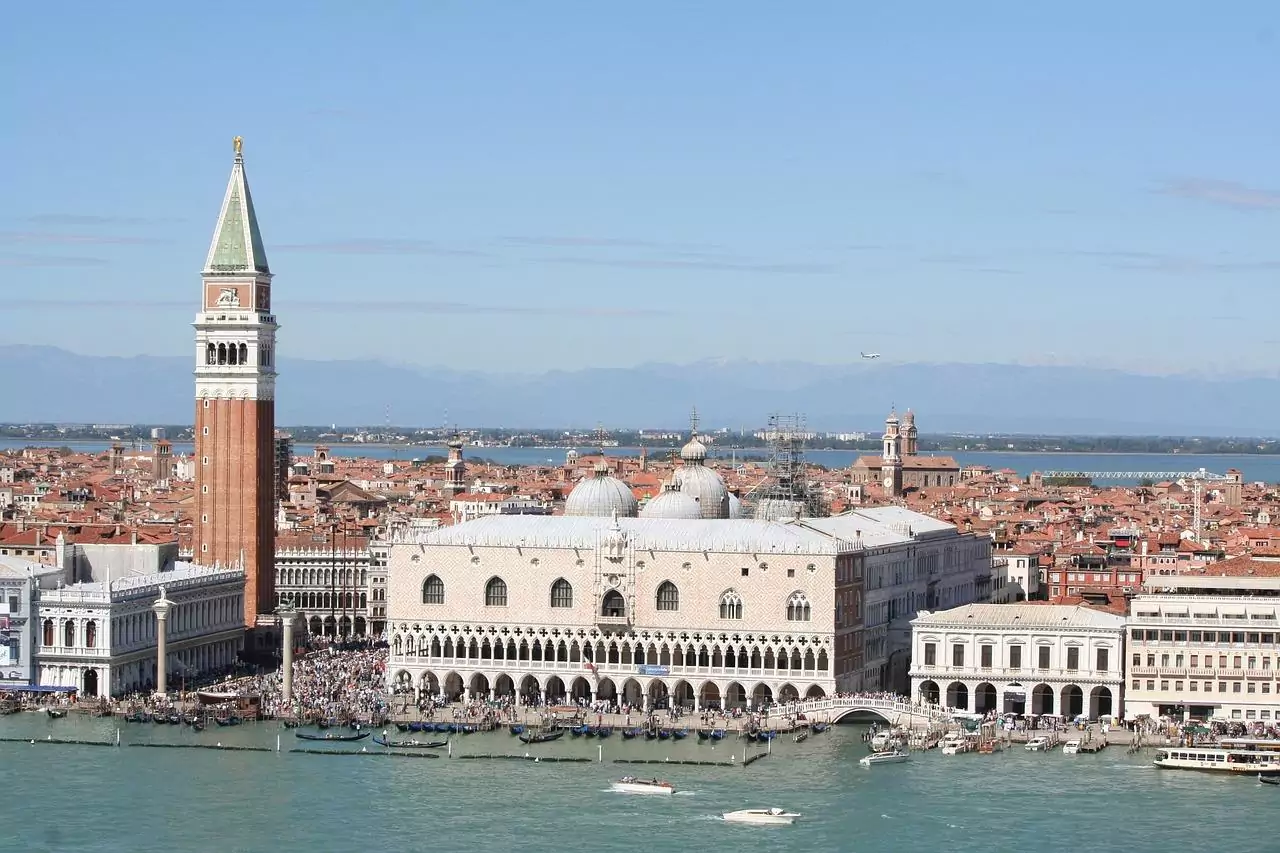
St. Mark’s Basilica (Basilica di San Marco)
St. Mark’s Basilica (Basilica di San Marco) is an architectural masterpiece and one of Venice’s most iconic landmarks. Located in the famous St. Mark’s Square, this stunning cathedral serves as a symbol of the city’s wealth, power, and artistic prowess throughout its history. Built in the 11th century to house the relics of St. Mark the Evangelist, the basilica showcases a unique fusion of Byzantine, Romanesque, and Gothic architectural styles. Its façade is adorned with intricate mosaics, marble inlays, and precious stones, while its interior dazzles with gold leaf and more than 8,000 square meters of intricate mosaics.
The basilica is also home to the Pala d’Oro, an exquisite altarpiece made of gold and precious gems, and the Treasury, which houses an impressive collection of religious artifacts. Visitors to St. Mark’s Basilica can expect long queues during peak season, so it’s advisable to book a timed-entry ticket online in advance. Once inside, take your time to explore the magnificent art and history that the basilica has to offer.
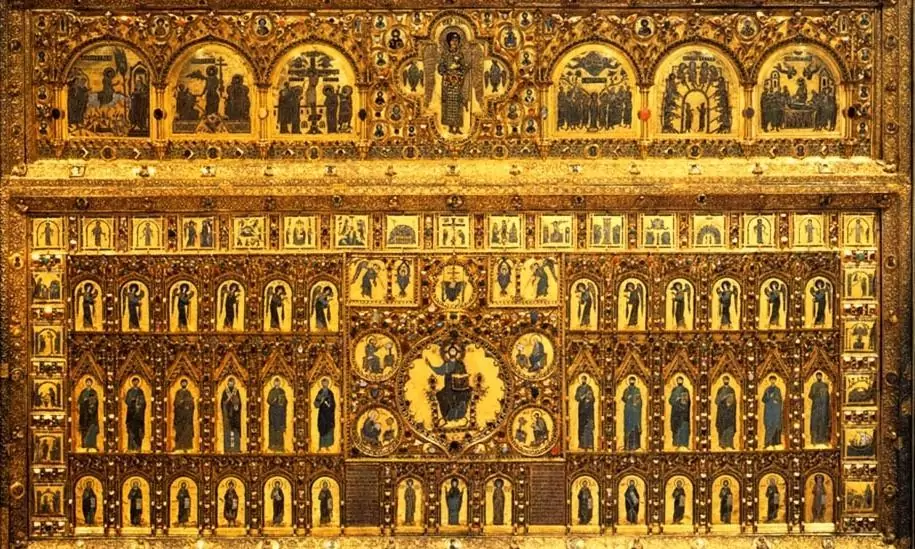
The St. Mark’s Basilica museum houses a diverse collection of artifacts, including intricate mosaics, precious liturgical objects, and original bronze horses that once adorned the basilica’s façade. As you navigate through the museum, you will be able to admire the stunning mosaics up close and gain insights into the craftsmanship and stories behind these masterpieces. In addition, the museum grants access to the Loggia dei Cavalli, an outdoor balcony overlooking St. Mark’s Square, where you can enjoy a breathtaking panoramic view of the square and its surroundings.
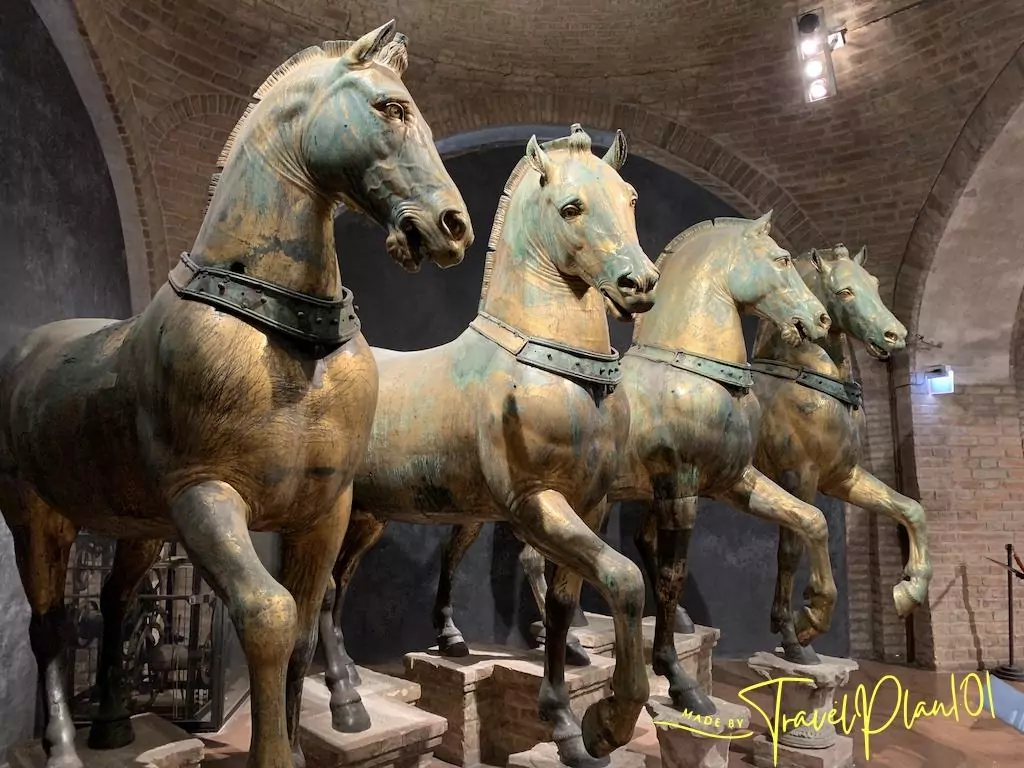
The top photo is the Saint Mark’s Horses (Italian: Cavalli di San Marco), which are a remarkable group of four bronze horse sculptures, rich in history and artistic significance. Originally part of a monument showcasing a quadriga, a four-horse racing chariot, these magnificent equine statues have a storied past. Believed to have been created in classical antiquity, the horses were later moved to Constantinople’s Hippodrome, where they became known as the Horses of Constantinople. In 1204, during the Fourth Crusade, they were looted by Venetian forces and subsequently installed on the façade of St. Mark’s Basilica in Venice, Italy. The horses remained there for centuries, gaining fame as symbols of Venice’s wealth and power. In the 1980s, due to concerns about environmental damage, the original sculptures were moved inside the basilica, and replicas were placed on the exterior. Today, visitors to St. Mark’s Basilica can admire these iconic and exquisite works of art within the basilica museum, marveling at their intricate details and storied history.
Peggy Guggenheim Collection
The Peggy Guggenheim Collection is a world-renowned modern art museum situated on the banks of the Grand Canal in the Dorsoduro district of Venice. Once the private residence of the legendary American art collector Peggy Guggenheim, the 18th-century Palazzo Venier dei Leoni now houses her impressive collection of modern art. The museum showcases masterpieces by some of the most influential European and American artists of the 20th century, including Pablo Picasso, Jackson Pollock, Salvador Dalí, and Max Ernst, among others. Visitors can admire a wide range of artistic styles, such as Cubism, Surrealism, and Abstract Expressionism. The museum also features a beautiful sculpture garden and a terrace overlooking the Grand Canal, providing a tranquil and inspiring environment for art lovers. The Peggy Guggenheim Collection is a must-visit destination for anyone interested in modern art and its history. It is highly recommended to book tickets online in advance to avoid long lines and ensure a smooth visit to this exceptional museum.
Rialto Bridge (Ponte di Rialto)
The Rialto Bridge (Ponte di Rialto) is one of Venice’s most famous landmarks and an essential stop on any visit to the city. Spanning the Grand Canal, this iconic stone bridge connects the bustling districts of San Polo and San Marco. Completed in 1591, it replaced the previous wooden bridge that had served as the main crossing point since the 12th century. Designed by architect Antonio da Ponte, the Rialto Bridge features a single, elegant arch adorned with shops selling a range of Venetian goods, from Murano glass to handmade souvenirs. The central portico offers a perfect vantage point to admire the bustling Grand Canal, with its vibrant parade of gondolas, water taxis, and vaporettos. As a major hub of Venetian life and commerce for centuries, the area surrounding the Rialto Bridge is filled with lively markets, historic buildings, and picturesque alleys, making it an ideal spot to immerse yourself in the city’s unique atmosphere.
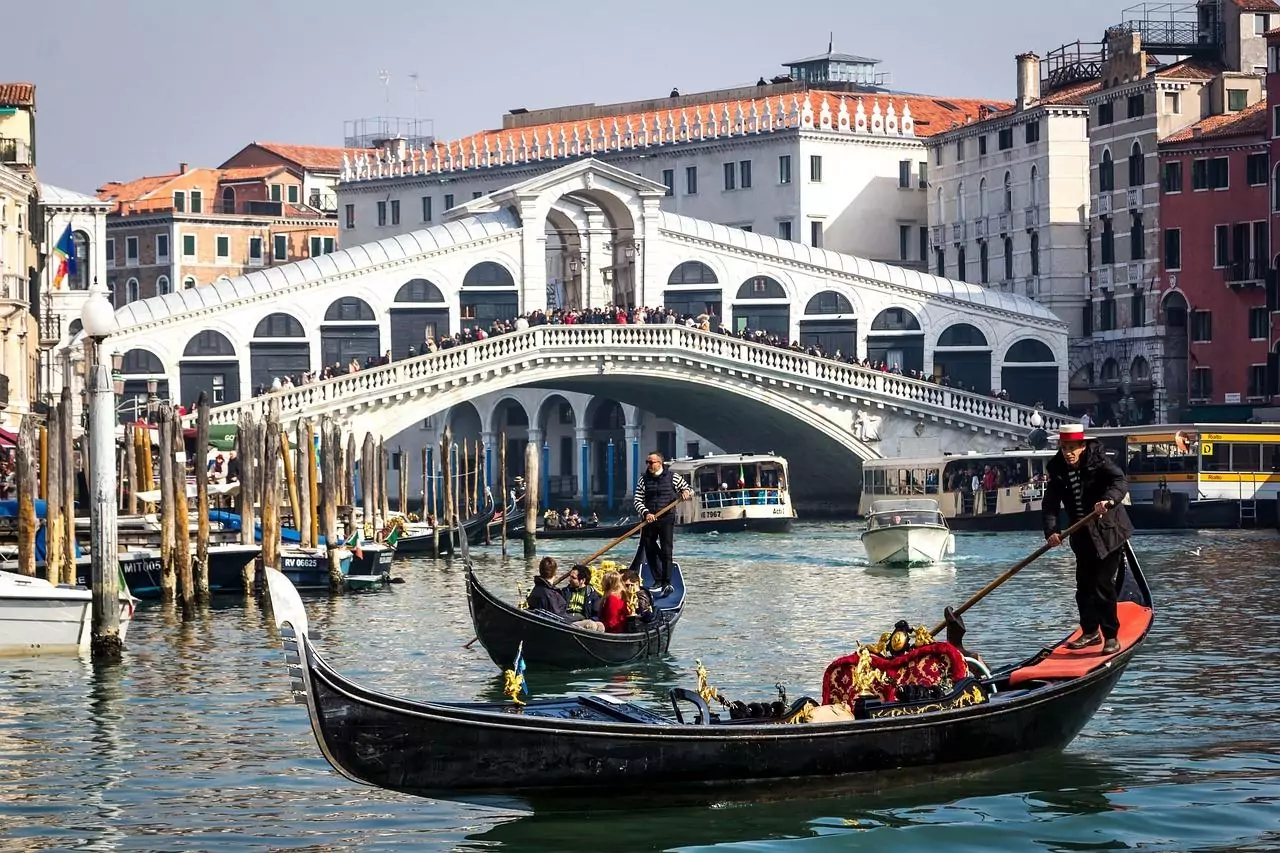
Bridge of Sighs (Ponte dei Sospiri)
The Bridge of Sighs, or Ponte dei Sospiri in Italian, is one of Venice’s most iconic and romantic landmarks. This exquisite white limestone bridge spans the Rio di Palazzo, connecting the Doge’s Palace to the historic prison, the Prigioni Nuove. Designed by Antonio Contino in the early 17th century, the enclosed bridge features two separate corridors, adorned with delicate Baroque-style lattice windows. The bridge’s evocative name is said to have originated from the sighs of the prisoners who caught their last glimpse of Venice’s beauty through the windows before being taken to their cells. Today, the Bridge of Sighs is a popular spot for tourists, who capture its elegance from various viewpoints, particularly from the nearby Ponte della Paglia. A gondola ride underneath the bridge is also a popular activity, as local legend suggests that a kiss shared under the bridge guarantees eternal love and happiness.
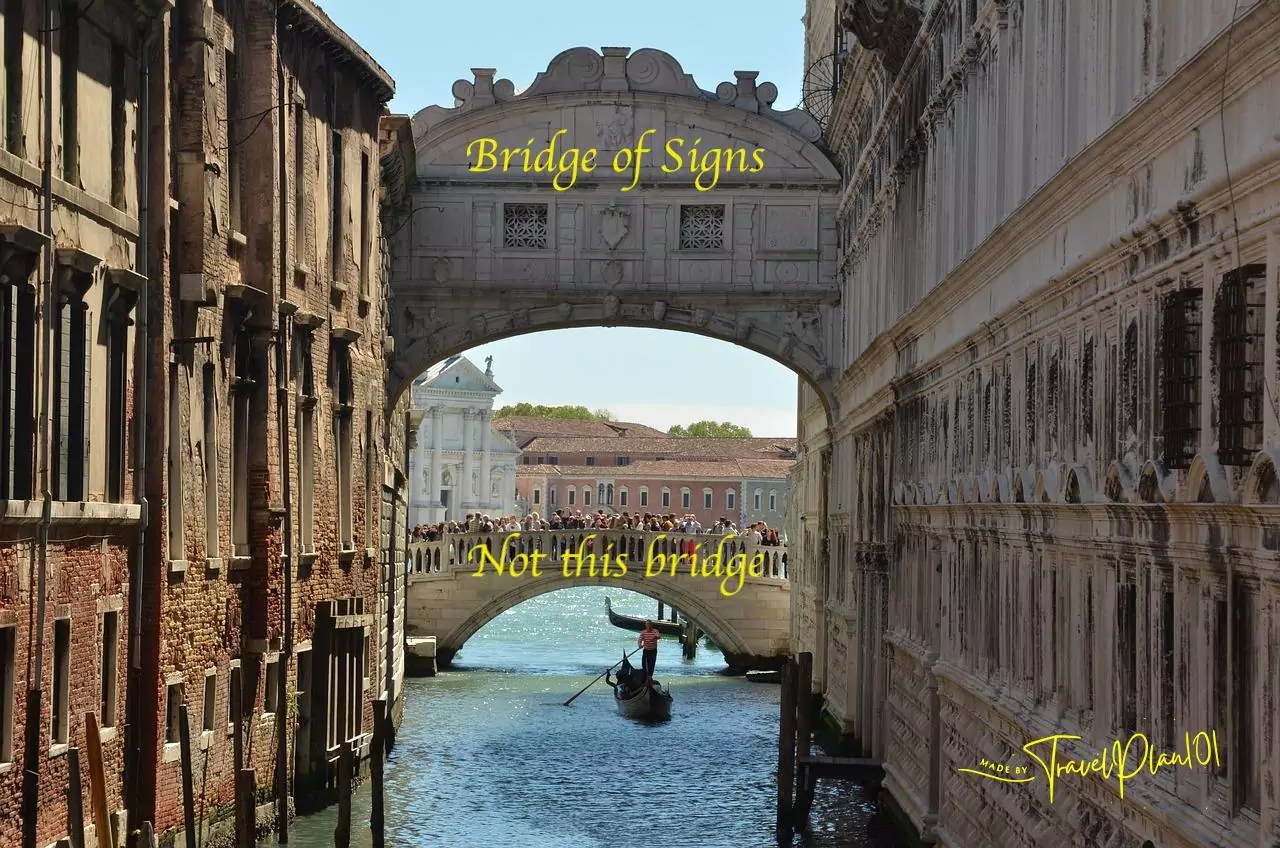
Bridge of Academia (Ponte dell’Accademia)
Ponte dell’Accademia is one of Venice’s most iconic and picturesque bridges, spanning the Grand Canal and connecting the districts of Dorsoduro and San Marco. Constructed from wood and painted white, this charming bridge offers some of the most stunning and romantic views of the city, particularly at sunset when the warm light reflects off the water. Named after the nearby Gallerie dell’Accademia, an art museum showcasing a vast collection of Venetian paintings, the bridge has become a popular spot for artists and photographers looking to capture the essence of Venice. As you stroll across Ponte dell’Accademia, be sure to take a moment to admire the breathtaking views of the city, the gondolas gliding along the canal, and the historic palazzos that line its banks.
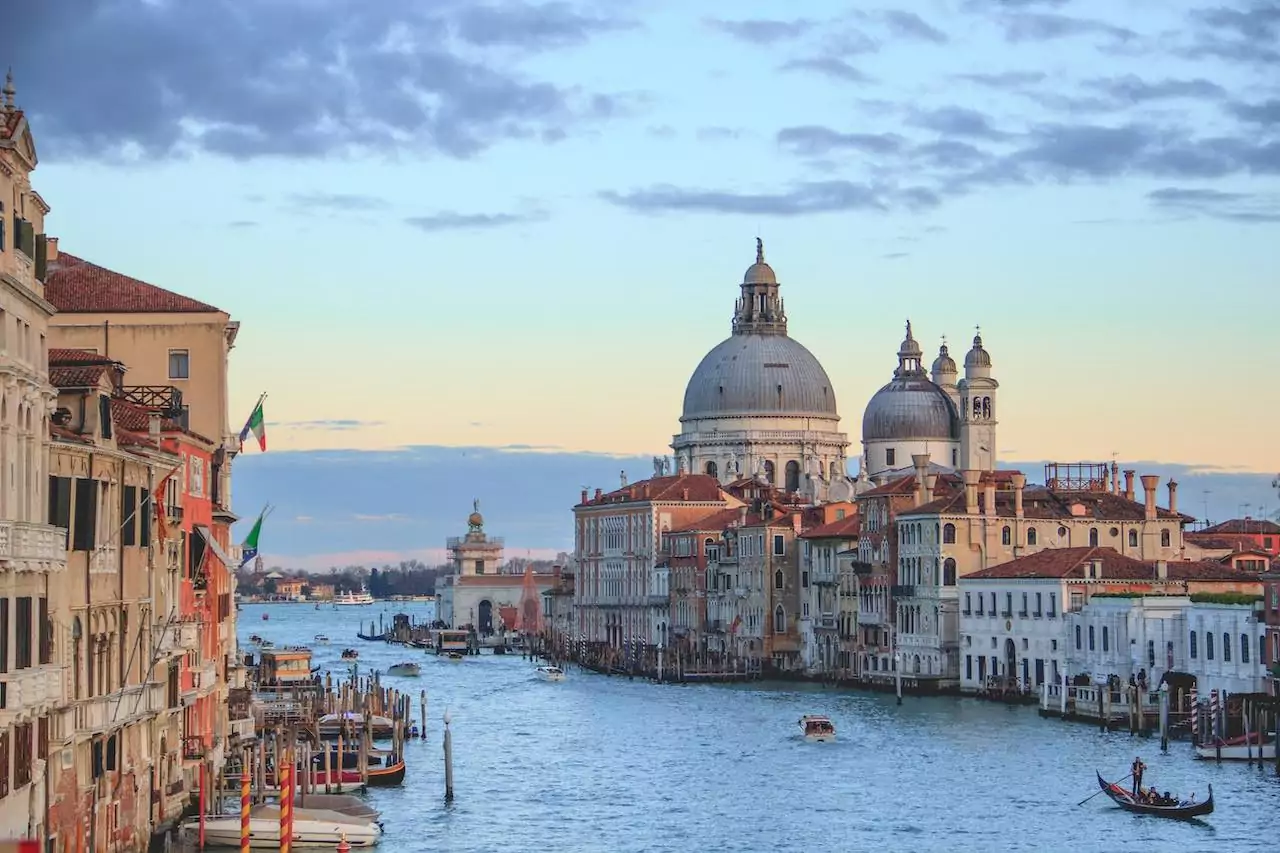
Santa Maria della Salute
Santa Maria della Salute, or Saint Mary of Health, is a stunning 17th-century Baroque basilica that stands at the entrance of the Grand Canal in Venice. This architectural marvel was designed by the renowned architect Baldassare Longhena as a response to the devastating plague of 1630, which wiped out a third of Venice’s population. The basilica was built as an offering to the Virgin Mary, seeking her protection and intercession to end the plague. The majestic octagonal structure is supported by over one million wooden pilings and features a magnificent dome, intricate carvings, and a wealth of sculptures that add to its grandeur. The interior of the church is adorned with impressive works of art, including paintings by Tintoretto and Titian. A visit to Santa Maria della Salute offers not only a glimpse into Venice’s rich history and artistic heritage but also breathtaking views of the city and the Grand Canal from its prominent location.
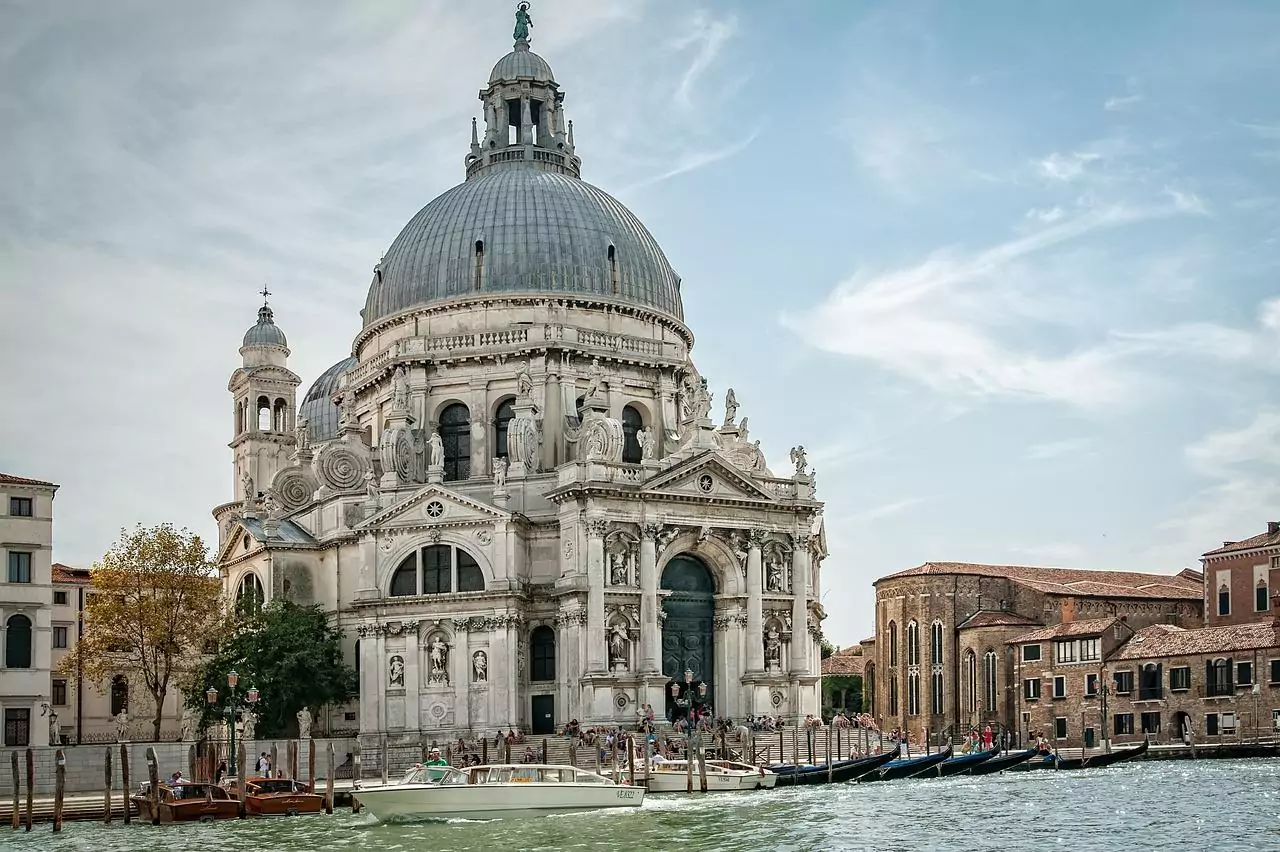
Murano Island (Glass Island)
Murano Island, located just a short vaporetto ride away from the heart of Venice, is world-renowned for its centuries-old tradition of glassmaking. This picturesque island has been the center of Venetian glass production since the 13th century, when glassmakers were relocated here from the main city to mitigate the risk of fires. Today, Murano is a thriving community of skilled artisans who continue to create exquisite glassware, ranging from delicate figurines and jewelry to intricate chandeliers and sculptures. Visitors to the island can explore the numerous glass studios, showrooms, and the Glass Museum (Museo del Vetro), which chronicles the history of glassmaking in Venice. Strolling through Murano’s charming streets, you’ll also discover vibrant buildings, quaint bridges, and lovely waterfront promenades, offering a more relaxed and authentic experience of Venetian life away from the bustling tourist areas.
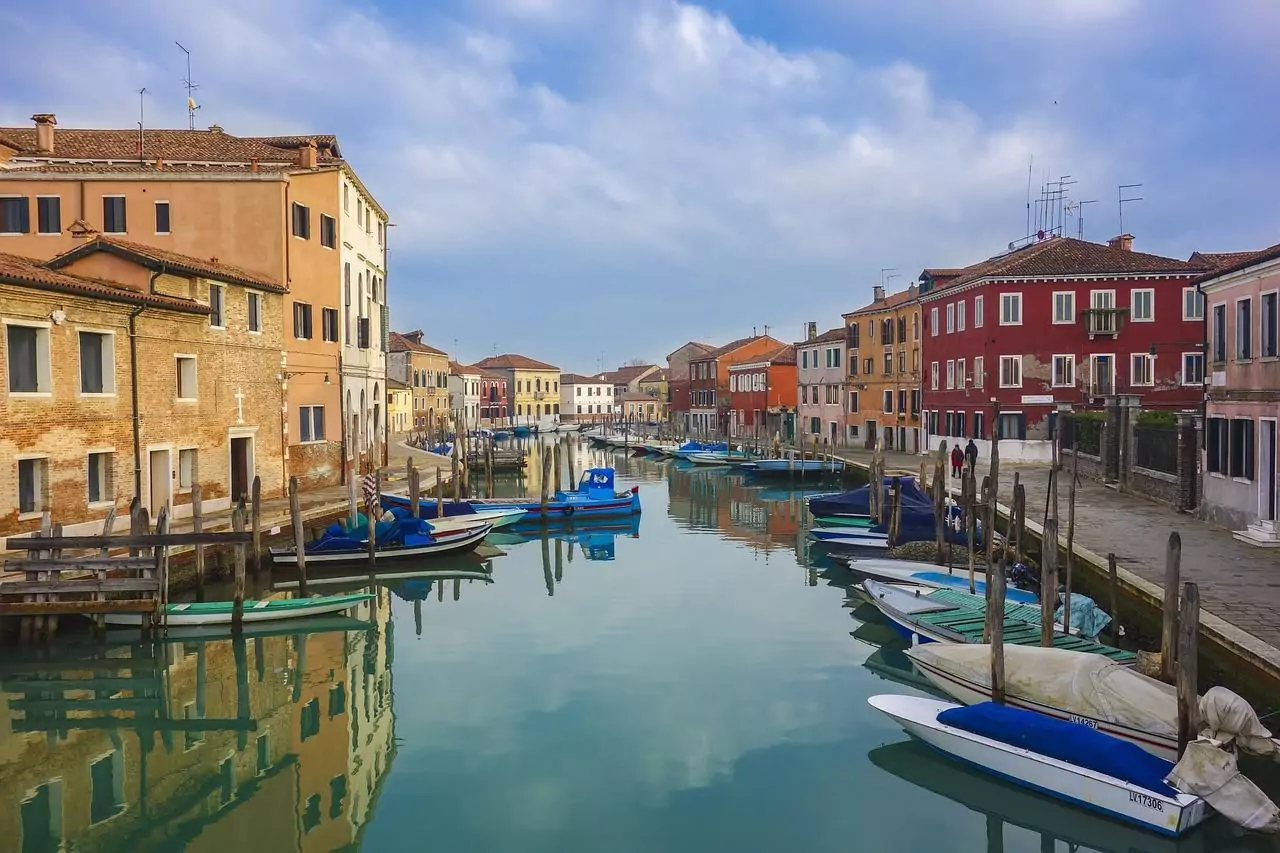
Burano Island (Colorful Island)
Burano Island is a vibrant and picturesque island located in the Venetian Lagoon, just a short vaporetto ride away from Venice. Known for its brightly colored fishermen’s houses, which are painted in a kaleidoscope of hues, Burano is a photographer’s dream and a delightful destination to explore on foot. The island is also famous for its centuries-old lace-making tradition, which dates back to the 16th century. The Lace Museum (Museo del Merletto) showcases the history and exquisite craftsmanship of Burano lace, and visitors can even watch skilled artisans at work in local workshops. In addition to lace, Burano offers charming streets, picturesque canals, and a lively atmosphere, with a variety of shops, galleries, and restaurants serving fresh seafood and traditional Venetian cuisine. Burano is a must-visit destination for anyone seeking a unique and colorful experience that captures the essence of Venice’s rich culture and artistic heritage.
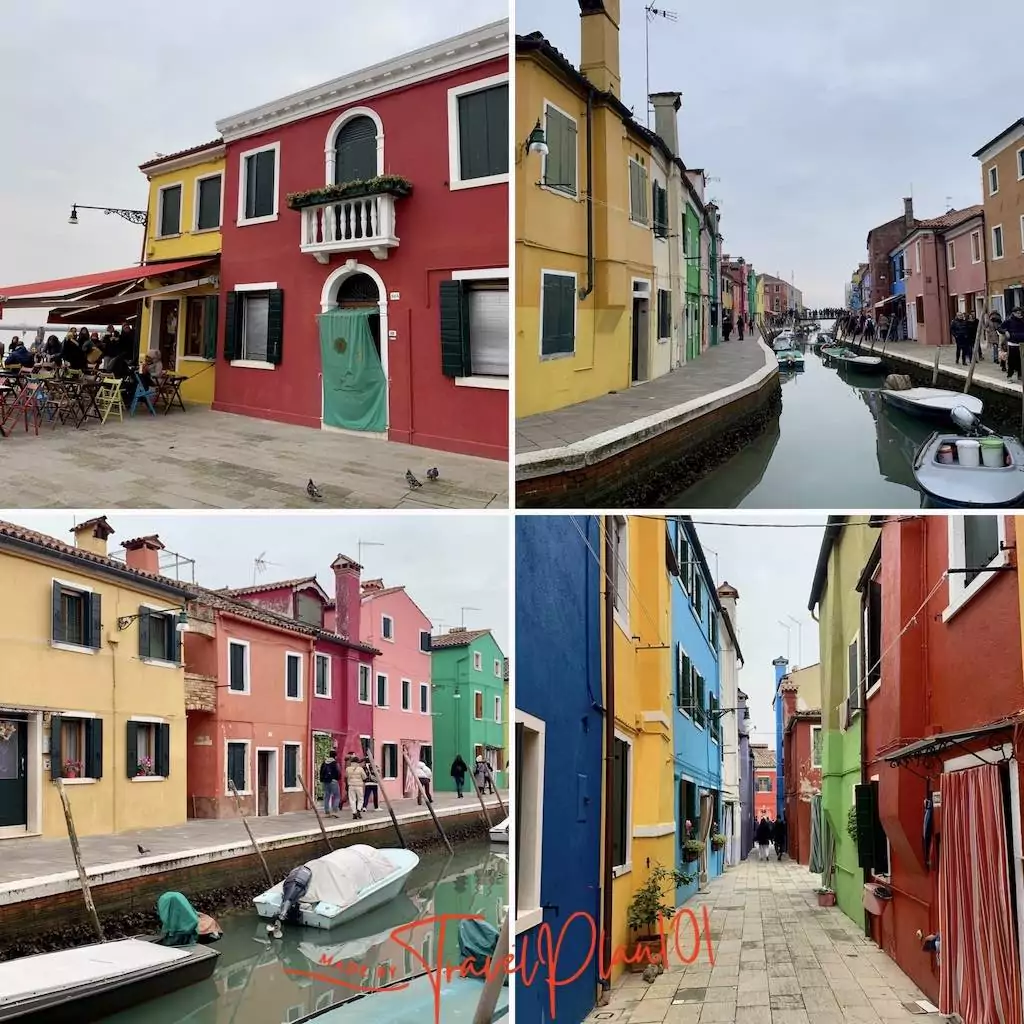

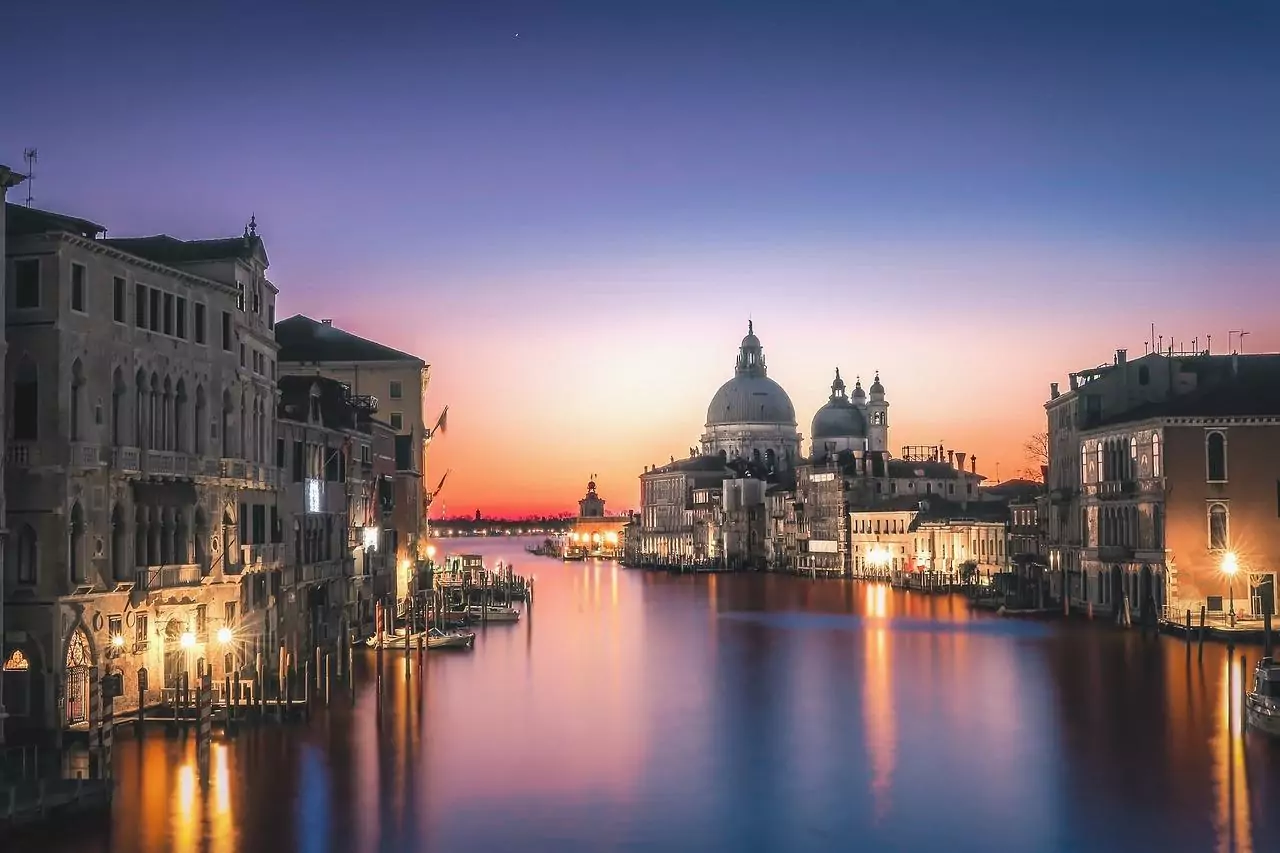
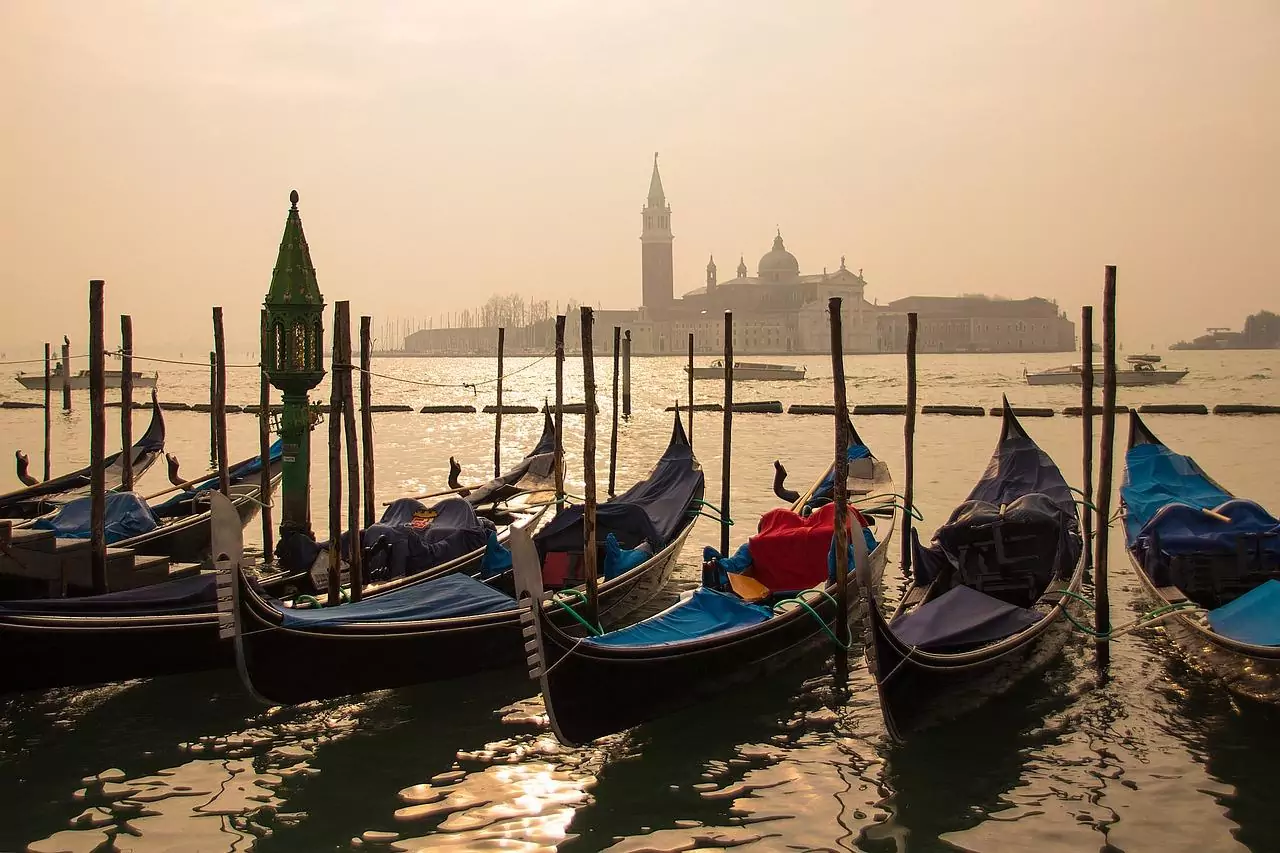


1 thought on “Venice Travel Guide”